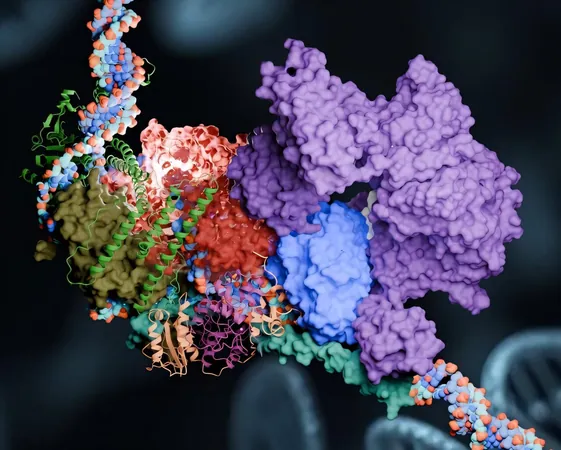
Supercomputers Unlock the Secrets of DNA Repair: A Breakthrough in Genetic Health!
2025-03-12
Author: John Tan
In the battle against the damaging effects of UV rays, tobacco smoke, and other carcinogens, not only is our skin taking a hit, but our DNA is also facing severe threats. With sunburns and aging as visible reminders, it’s essential to understand that DNA damage is a significant concern that stretches beyond the surface.
A groundbreaking study led by researchers at Georgia State University, utilizing the powerful Summit supercomputer at Oak Ridge National Laboratory, is shedding light on the intricate molecular mechanisms behind DNA repair. Their focus is on a sophisticated process known as nucleotide excision repair (NER), which involves a series of dynamic protein complexes that work together to surgically excise damaged DNA.
Published in Nature Communications, the study delineates the model they have constructed for a pivotal component in this repair system known as the pre-incision complex (PInC). This essential structure regulates the critical final stages of NER and understanding this could pave the way for new therapies targeting genetic disorders and various cancers, ultimately impacting our approach to aging and disease prevention.
Lead investigator Ivaylo Ivanov, a chemistry professor at Georgia State, encapsulates the essence of their work: “Cells have incredible mechanisms for repairing their DNA, but mutations can disrupt these processes, leading to severe health issues.” The variations in outcomes from different genetic mutations create a complex puzzle—some result in heightened sensitivity to UV light, while others may lead to developmental abnormalities and accelerated aging. Unraveling the mystery of these reactions is at the core of their research.
The Three Stages of DNA Repair: How Your Body Heals Itself
The NER process consists of three main stages: recognition, verification, and repair—akin to a medical team working synergistically to treat injuries. At the forefront is the protein XPC, acting as the first responder that identifies damaged DNA and prepares it for a thorough inspection by other repair proteins.
During the verification phase, XPC steps back, and the complex known as transcription factor IIH (TFIIH) takes its place, further unwinding and examining the damaged DNA. It’s in the final phase that the PInC comes into action, cutting the damaged strand of DNA with the precision of molecular scissors (enzymes XPF and XPG), allowing for new DNA to fill the gap created.
Ivanov emphasizes the importance of understanding how the PInC assembles after the scanning process. “We must understand the dynamics of the enzymes involved and their interactions,” he notes, explaining that completing the repair is crucial to prevent detrimental outcomes like cell death or severe genetic breaks.
Revolutionary Computational Techniques: The Future of Genetic Research
To successfully map the structure of the PInC, the researchers harnessed a combination of biophysical data and supercomputing power. AlphaFold2, a neural network-based tool, predicted unknown protein structures, filling gaps in their understanding and assembling the parts into a cohesive 3D model. As Ivanov explains, “Each part of this complex is like a piece of a jigsaw puzzle, and computational power is key to piecing it together.”
Thanks to the Summit supercomputer’s extraordinary capabilities—processing over 200 quadrillion calculations per second—the researchers conducted extensive molecular dynamics simulations. These simulations revealed detailed insights into how components of PInC interact dynamically, which are crucial for understanding how mutations in repair proteins XPF and XPG can lead to severe genetic disorders like xeroderma pigmentosum and Cockayne syndrome.
With Summit's retirement set for 2024, the team is now looking forward to utilizing its successor, Frontier, the world’s most powerful supercomputer. They will broaden their research to include transcription-coupled NER, focusing on repairing active genes to maintain essential protein production.
This innovative work represents a massive leap forward in our understanding of genetic repair processes, emphasizing the importance of supercomputer technology in unlocking the biological mysteries that could lead to significant breakthroughs in medical treatments. The implications for human health are vast, potentially revolutionizing how genetic disorders and aging-related diseases are approached in the future.
Stay tuned as we continue to cover advancements in genetic research and the incredible role technology plays in reshaping our understanding of human health!


 Brasil (PT)
Brasil (PT)
 Canada (EN)
Canada (EN)
 Chile (ES)
Chile (ES)
 Česko (CS)
Česko (CS)
 대한민국 (KO)
대한민국 (KO)
 España (ES)
España (ES)
 France (FR)
France (FR)
 Hong Kong (EN)
Hong Kong (EN)
 Italia (IT)
Italia (IT)
 日本 (JA)
日本 (JA)
 Magyarország (HU)
Magyarország (HU)
 Norge (NO)
Norge (NO)
 Polska (PL)
Polska (PL)
 Schweiz (DE)
Schweiz (DE)
 Singapore (EN)
Singapore (EN)
 Sverige (SV)
Sverige (SV)
 Suomi (FI)
Suomi (FI)
 Türkiye (TR)
Türkiye (TR)
 الإمارات العربية المتحدة (AR)
الإمارات العربية المتحدة (AR)